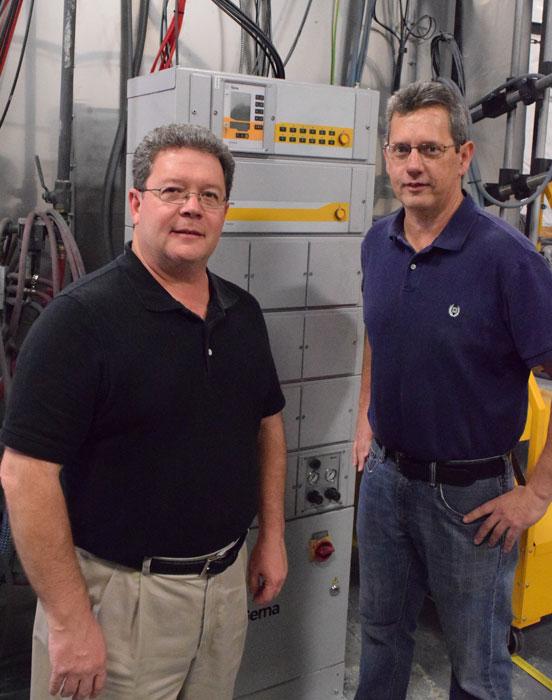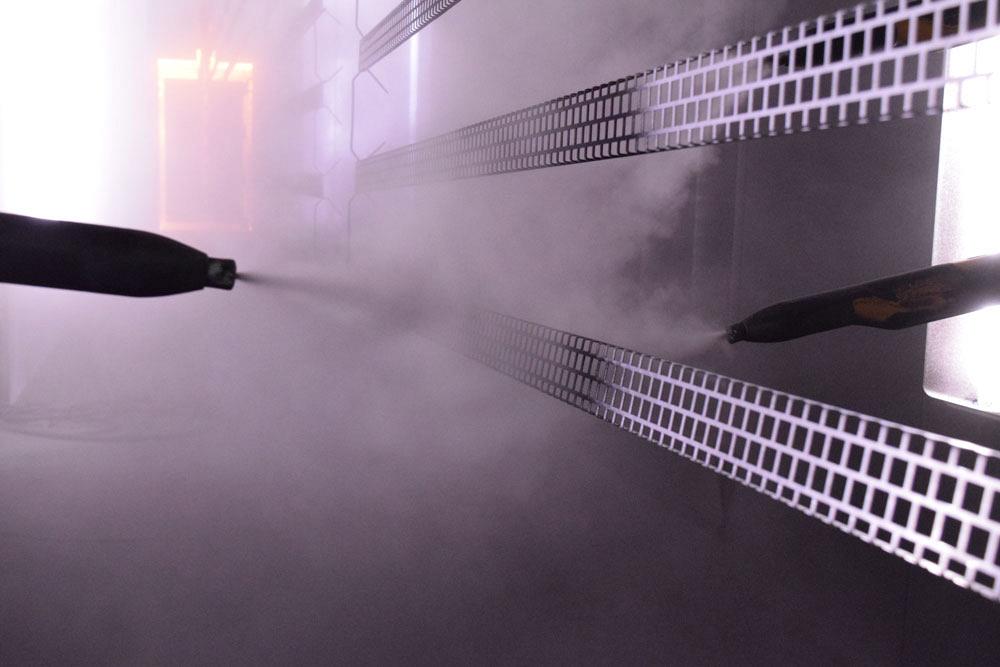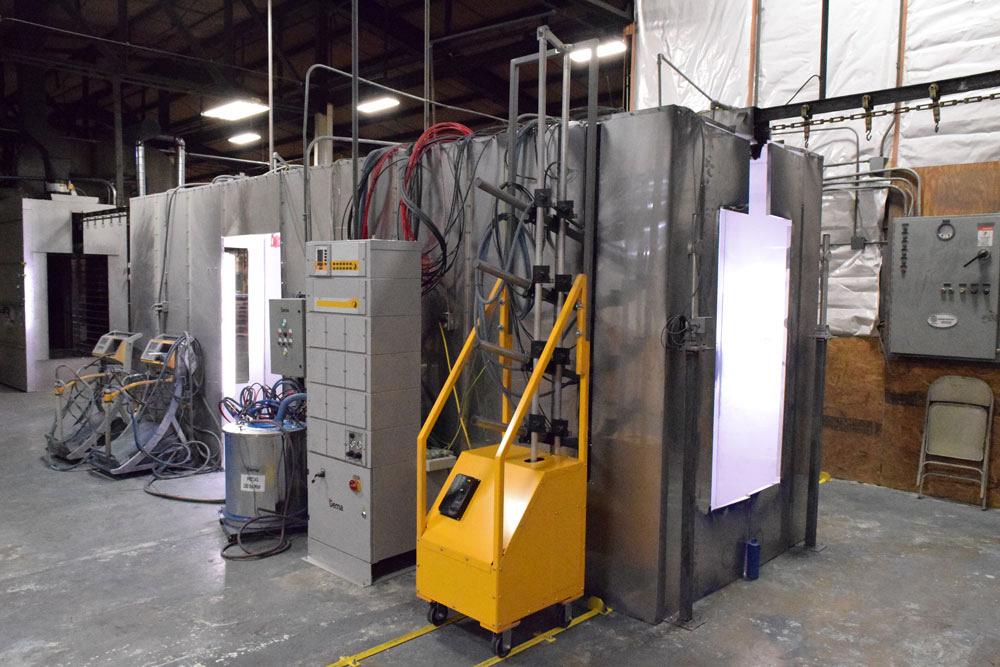Director of Marketing
- FMA
- The Fabricator
- FABTECH
- Canadian Metalworking
Categories
- Additive Manufacturing
- Aluminum Welding
- Arc Welding
- Assembly and Joining
- Automation and Robotics
- Bending and Forming
- Consumables
- Cutting and Weld Prep
- Electric Vehicles
- En Español
- Finishing
- Hydroforming
- Laser Cutting
- Laser Welding
- Machining
- Manufacturing Software
- Materials Handling
- Metals/Materials
- Oxyfuel Cutting
- Plasma Cutting
- Power Tools
- Punching and Other Holemaking
- Roll Forming
- Safety
- Sawing
- Shearing
- Shop Management
- Testing and Measuring
- Tube and Pipe Fabrication
- Tube and Pipe Production
- Waterjet Cutting
Industry Directory
Webcasts
Podcasts
FAB 40
Advertise
Subscribe
Account Login
Search
Automating powder coat system, adding IR curing accelerate productivity
Fabricator eliminates bottlenecks, frees up opportunities
Matthews Industries is a family-owned metal fabricator located in Decatur, Ala. The manufacturer offers fabricating, welding, coating, and assembly services, as well as machining. It manufactures compressed air systems, food service equipment, HVAC/refrigeration components, cabinets and electrical enclosures, industrial valves, and consumer products (see Figure 1).
For 68 years the Matthews family has focused on performing quality work at a fair price. This core value has guided the company’s decisions to find ways to improve efficiencies and reduce the costs of operation to maintain its commitment to providing value to customers.
Each generation of the family has seized efficiency opportunities by implementing changes and updating equipment. Third-generation co-owner/President Paul Matthews is no different (see Figure 2). Earlier this year Matthews invested in new, automated application equipment for the powder coating line that his father had implemented in 2000 to reduce volatile organic compounds (VOCs) emissions and the costs and headaches associated with chemical waste disposal.
Batch sizes vary broadly, as do part sizes. “Our batches can be as small as a couple of parts to hundreds of parts,” said Randy McNutt, production supervisor. Matthews added, “Parts range from small enough to fit in the palm of your hand to 10 feet long and 5 feet tall.”
To meet rising production volumes in a range of part and batch sizes, Matthews Industries not only doubled the number of coating operators, it expanded the operational hours of the coating line to five days a week, up to 10 hours a day (see Figure 3).
Once the company was able to meet its production volumes, Matthews and McNutt concluded that this arrangement was not an efficient or profitable model for long-term success, considering that it has global competition creating cost pressures. “Products produced in Mexico and China were lower in cost,” Matthews said. In addition, the ISO 9001:2015-certified company was tasked with focusing on quality and continuous improvement. “Our production quality was good, and we knew that our 5-stage pretreatment system gave us an advantage on the finish quality. However, we needed to remove cost and increase our productivity. We needed to remove our bottlenecks.”
First Bottleneck: Powder Coat Application
Applying the powder coating in the finishing line was a bottleneck. “We needed more product out the door, and our line did not provide the automation or flexibility that we needed,” Matthews said. However, this was challenging because line density was hindering productivity.
Because the four operators sprayed the powder manually, they needed to have ample time and space to coat the parts. The space between the parts on the line had to be large to accommodate the operators’ coating capabilities.
“We tried to hang parts closer together but that caused problems for our operators. They couldn’t keep up,” McNutt said. “We had to slow down the line and spread the parts farther apart so the operators had room to work all around the product.”
“Depending on the size of the part, they had to have a certain amount of room to spray between x and y parts,” Matthews added. “We decided we had to go a different route so we could be competitive.”

Figure 1
Matthews Industries fabricates compressed air systems, food service equipment, HVAC/refrigeration components, cabinets and electrical enclosures, industrial valves, and consumer products. Finishing the metal fabrications the company manufactures and assembles is just part of its offerings.
Matthews and McNutt investigated converting from a manual powder coating operation to mostly automatic powder spray guns. “We started researching the things we could do to speed up the line and put parts closer together and we came up with the automatic guns,” McNutt said.
Exploring Automated Application. Matthews and McNutt had used Gema powder coating spray equipment, so they reached out to the OEM and its distributor, CCIS, to discuss possible solutions. McNutt said, “We wanted to automate, but needed to find a system that could be easily integrated in our current system and allow us to produce more parts.”
They had some concerns as well. “Obviously, cleanup was a concern. How long will it take to change over from one color to another? Our powder usage was another. Would our efficiency deteriorate? How big of a negative might that be?” Matthews said.
McNutt researched two or three different brands and types of automatic spray guns. “We were already familiar with Gema because we had been using that type of gun.” The company chose a Gema MultiStar automatic package that controls eight automatic powder spray guns mounted on a gun mover (see Figure 4). The gun mover moves up and down and oscillates to get into the optimal position to spray the part.
Because the automated guns require less space than a human operator, the company was able to decrease the space between parts. “We were able to significantly increase product line density, double the line speed, and coat many of our parts 100 percent automatically,” Matthews said.
The powder coating system can process many colors; however, six colors represent the bulk of the production. When applying those six colors, the company powder-coats the parts 100 percent automatically. Operators spray the other colors and low-volume part batches that represent frequent changeovers. They also apply the coating to tricky areas such as interior corners and components larger than 53 in. “We still have to have a human operator at a separate station to hit certain areas of a part that the guns won’t quite reach, where they have to come in at an angle to hit a corner,” Matthews said. “But there’s not a fatigue factor because they’re not spraying the same volume that they had been.”
Second Bottleneck: Curing
Once the first bottleneck was eliminated, a second bottleneck became apparent: the curing oven. “Our baking oven was a limiting factor because it determined how fast we could run the line. A part would get halfway through the bake oven before it ever got to the curing temperature,” McNutt said.
“So we had to do something to get parts up to curing temperature faster; otherwise we’d be in the same seat we were before.”McNutt and Matthews investigated getting an infrared (IR) oven to preheat the parts before they enter the curing oven. “We learned that we could use electric infrared heating in combination with the gas oven,” Matthews said. The IR panels offer high- efficiency heating with fast response time and the ability to control the heat in zones based on the size of the part entering the oven. The two men met with a regional power company to run adhesion tests on their parts with various powders in the electric IR system. “It went very well,” Matthews said.
The company invested in BGK high-intensity IR panels and installed them in the entrance to their existing gas-fired cure oven. Now, after a part goes through a powder coating operation, it feeds on a conveyor line into the bank of IR bulbs before it enters the gas-fired heater oven (see Figure 5).

Figure 2
Co-owner/President Paul Matthews (left) and Production Supervisor Randy McNutt explored ways to wring out inefficiencies and smooth out bottlenecks in their operations to help the company to cost-compete.
“We get the parts up to our curing temperature almost immediately as they go through the IR oven. The part stays at the curing temperature through the bake oven,” McNutt said.
Matthews added, “It’s important because it boosts our curing speed. We essentially doubled our line speeds.”
Net Result
Matthews and McNutt said they are very pleased with the results of the upgrades. “It took us from a mindset of ‘We paint because it’s necessary’ to ‘We paint because we like to paint.’ It became dramatically easier,” McNutt said.
“The changes in coating and curing equipment have really done a lot to eliminate the bottleneck, reduce our operational cost, and improve plant productivity. Our line has more flexibility than we have ever had,” McNutt said.
Matthews added, “Our gas consumption has gone down considerably—about 40 percent.”
McNutt said that pretreatment chemical usage has almost been cut in half as well. “The usage and cost of the chemicals that we were using to treat the parts dropped by about 40 to 50 percent also because we’re running the line only about two days a week now compared to five days a week before.”
The new systems’ impact on electricity usage is harder to ascertain, they said. “It is about the same, but we were doing some other things with our lighting and our air compressor technology. So our electricity usage is about the same, but that’s not 100 percent attributed to what we did on the paint line, because we were making changes in other areas of the plant at the same time,” Matthews said.
Regarding the two concerns Matthews had about line changes and powder usage, one turned out to be valid and one was not.
“Color changeover was hard to start with but since has not been an issue,” McNutt said. Powder consumption has increased, however. “Overall we do use more powder. Powder costs did increase. You’re spraying more guns so you’re going to have more waste,” McNutt said.
“I wouldn’t want to mislead your readers,” Matthews said, adding, “We choose not to reclaim … so far.”

Figure 3
Manual operators performed well but needed ample room to apply the powder coating. The company sought to increase line density to improve productivity
Since making these changes, Matthews now hears opportunity knocking at the door again. “We have available line time that could be used as a new revenue stream.” With this in mind, the company plans to offer powder coating services.
Jeff Hale is marketing director for Gema USA Inc., www.gemapowdercoating.com.
Matthews Industries, www.matthewsindustries.com
About the Author
subscribe now

The Fabricator is North America's leading magazine for the metal forming and fabricating industry. The magazine delivers the news, technical articles, and case histories that enable fabricators to do their jobs more efficiently. The Fabricator has served the industry since 1970.
start your free subscription- Stay connected from anywhere

Easily access valuable industry resources now with full access to the digital edition of The Fabricator.

Easily access valuable industry resources now with full access to the digital edition of The Welder.

Easily access valuable industry resources now with full access to the digital edition of The Tube and Pipe Journal.
- Podcasting
- Podcast:
- The Fabricator Podcast
- Published:
- 04/30/2024
- Running Time:
- 53:00
Seth Feldman of Iowa-based Wertzbaugher Services joins The Fabricator Podcast to offer his take as a Gen Zer...
- Industry Events
Pipe and Tube Conference
- May 21 - 22, 2024
- Omaha, NE
World-Class Roll Forming Workshop
- June 5 - 6, 2024
- Louisville, KY
Advanced Laser Application Workshop
- June 25 - 27, 2024
- Novi, MI
Precision Press Brake Certificate Course
- July 31 - August 1, 2024
- Elgin,

































